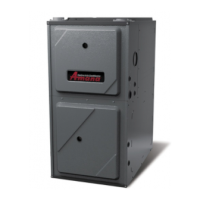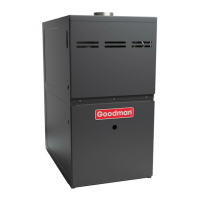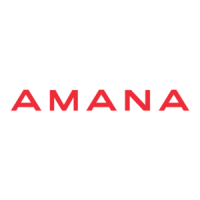SYSTEM OPERATION
15
recommendations and to verify that all vent/ue piping and
connectors are compatible with furnace flue products.
Additionally, it is the responsibility of the installer to ensure
that all piping and connections possess adequate structural
integrity and support to prevent ue pipe separation, shifting,
or sagging during furnace operation.
D
The 90% furnace is dual certied and may be installed as
a non-direct vent (single pipe) or direct vent (dual pipe)
appliance. A non-direct vent installation requires only a vent/
ue pipe. A direct vent installation requires both a vent/ue
pipe and a combustion air intake pipe. Refer to the appropriate
section for details concerning piping size, length, number of
elbows, furnace connections, and terminations.
WARNING
AVID DIL INJR IRE R EXPLSIN SLVEN CEMENS MS E
KEP AWA RM ALL IGNIIN SRCES IE SPARKS PEN LAMES AND
EXCESSIVE EA AS E ARE CMSILE LIQIDS
A
VID REAING
CEMEN VAPRS R CNAC WI SKIN AND/R EES
Precautions should be taken to prevent condensate from
freezing inside the vent/ue pipe and/or at the vent/ue pipe
termination. It is our recommendation that all vent/ue piping
exposed to temperatures below 35°F for extended periods
of time should be insulated with 1/2” thick closed cell foam.
Also all vent/ue piping exposed outdoors in excess of the
terminations shown in this manual (or in unheated areas)
should be insulated with 1/2” thick closed cell foam. Inspect
piping for leaks prior to installing insulation.
The following bullets and diagram describe the restrictions
concerning the appropriate location of vent/ue pipe and
combustion air intake pipe (when applicable) terminations.
Refer to the installation instructions for specic details on
termination construction.
• All terminations must be located at least 12 inches above
ground level or the anticipated snow level.
• Vent terminations must terminate at least 3 feet above
any forced air inlet located within 10 feet.
• This provision does not apply to the combustion
air intake termination of a direct vent application.
• The vent termination of a non-direct vent application
must terminate at least 4 feet below, 4 feet horizontally
from, or 1 foot above any door, window, or gravity air
inlet into any building.
• The vent termination of a direct vent application must
terminate at least 12 inches from any opening through
which ue gases may enter a building (door, window,
or gravity air inlet).
• The vent termination of vent pipe run vertically through
a roof must terminate at least 12 inches above the roof
line (or the anticipated snow level) and be at least 12
inches from any vertical wall (including any anticipated
snow build up).
• A vent termination shall not terminate over public
walkways or over an area where condensate or
vapor could create a nuisance or hazard or could be
detrimental to the operation of regulators, relief valves,
or other equipment.
• The combustion air intake termination of a direct vent
application should not terminate in an area which is
frequently dusty or dirty.
In Canada, the B149 Fuel Gas Code takes precedence
over the preceding termination restrictions.
On upow units secure the combustion air intake pipe directly
to the air intake coupling. On counterow units secure the
combustion air intake pipe to the air intake coupling using the
rubber coupling and worm gear hose clamps provided with the
unit. The counterow rubber coupling allows service removal
of air intake piping internal to the furnace blower compartment.
The combustion air intake pipe can also be secured directly
to the counterow unit air intake pipe coupling.
A minimum of one 90° elbow must be installed on the
combustion air intake “coupling” to guard against inadvertent
blockage.
WARNING
E RER ELW IS N DESIGNED SPPRA A LAD
W
EN E
RER ELW IS MNED EXERNALL E RNACE CAINE
EX
REME CARE
MS E
AKE
N ADEQ
AEL S
PPR IELD
-S
PPLIED
VEN/LE PIPING AS DAMAGE CAN RESL IN LEAKS CASING DIL
INJR R DEA DE EXPSRE LE GASES INCLDING CARN
MNXIDE
E SRE N DAMAGE INERNAL WIRING R ER CMPNENS WEN
REINSALLING CPLING AND SCREWS
Refer to the following tables for applicable length, elbows, and
pipe diameter for construction of the vent/ue pipe system of a
non-direct vent installation. In addition to the vent/ue pipe, a
single 90° elbow must be secured to the combustion air intake
to prevent inadvertent blockage. The tee or elbows used in
the vent/ue termination must be included when determining
the number of elbows in the piping system.

